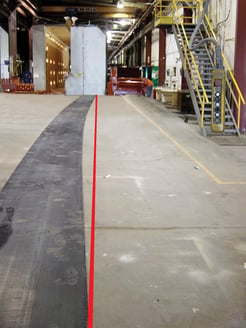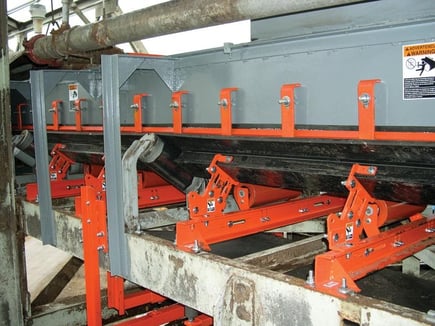By Jerad Heitzler on May 11, 2023 1:15:59 PM
One of the biggest problems we often hear our customers ask about is 'how to track a belt.' We're going to give you some of the strategies we've found effective over the course of 75+ years of tracking conveyor belts.
Why Does A Conveyor Belt Mistrack?
There are reasons why a belt will mistrack...it doesn't just mistrack naturally. Typically, there are two categories of root causes as to why belts mistrack: operating conditions or equipment conditions. Operating conditions are the things you're doing to cause the belt to mistrack.
Operating Conditions
 Rolling components have an influence on the belt but in order for a rolling component to steer the belt correctly, it must be clean. When carryback builds up on return rolls, that tends to cause the belt to wander. You want to make sure you have belt scrapers/cleaners installed and that they are properly maintained. They must be tensioned properly. Most times, we're going to recommend a multiple-cleaner belt cleaning system, consisting of a primary cleaner - typically with a urethane blade - and a secondary cleaner with tungsten carbide. Bend pulleys, take-up pulleys, carrying idlers, return rollers - they all must be clean. They can't be caked with material buildup.
Rolling components have an influence on the belt but in order for a rolling component to steer the belt correctly, it must be clean. When carryback builds up on return rolls, that tends to cause the belt to wander. You want to make sure you have belt scrapers/cleaners installed and that they are properly maintained. They must be tensioned properly. Most times, we're going to recommend a multiple-cleaner belt cleaning system, consisting of a primary cleaner - typically with a urethane blade - and a secondary cleaner with tungsten carbide. Bend pulleys, take-up pulleys, carrying idlers, return rollers - they all must be clean. They can't be caked with material buildup.
Another operating condition adding to this wildly important statement is seized rollers. If you've got seized rollers, they are not rolling and the belt will suffer.
Loading Conditions
There are two types of loading conditions that can cause the belt to mistrack: off-center loading & segregated loading.
Off-center loading is pretty self-explanatory, it's when you're loading material onto one side of the belt and that load pushes the belt up into the carrying idlers, causing spillage.
Segregated loading is a little bit different and is most common in the mining industry. Anytime you're dealing with material coming from the ground, that material isn't going to be consistent in size until after running through a couple of different crushers. So, the material can have some big chunks in it as well as very fine material. What happens when material containing big chunks and small fines is being conveyed is that it's also being vibrated. That vibration will cause the fines to sift to the bottom and the big chunks will migrate to the top.
When you've got a conveyor belt with big chunks on one side or on the top and small fines on the bottom and that conveyor dumps onto another conveyor running at a 90-degree angle, those big chunks on the top will fly out to the outer edge of the belt. The small fines will drop to the side of the belt and the improper distribution of weight can cause the belt to mistrack.
Another underrated reason why a belt mistracks is lack of maintenance, often improperly adjusting skirting. What happens is maintenance staff will see dust or spillage coming out from underneath the skirtboard and they make adjustments down on that skirtboard. When that skirting becomes unevenly adjusted and one side of the belt has more drag than the other side, the side of the belt that has more drag moves a little bit slower. This can cause a little bit of belt mistracking. A good practice to avoid that problem is to make sure that you're supporting the belts with closely stacked idlers. The idlers are stacked together so they can't create excess wear on the skirting, causing drag and belt mistracking.
Don't assume that every one of these problems is going to absolutely, positively cause a belt to mistrack. Sometimes, they're insignificant problems but they certainly can contribute to the belt's likelihood to mistrack.
Equipment Conditions
Equipment conditions that will cause a belt to mistrack are bent, loose, or misaligned rollers/structures. As previously mentioned, all rolling components steer the belt. But, in order for a rolling component to steer the belt correctly, it must also be aligned.
If you've got rollers or structures that are not aligned, the belt will mistrack. Make sure that all pulleys are aligned, specifically terminal pulleys. Terminal pulleys include head and tail pulleys and if included on the conveyor, take-up, bend, and snub pulleys.
Two of the most overlooked reasons why a belt mistracks are improper splicing and improper belt storage. A lot of facilities, when squaring to cut a belt, use edges that may not be straight. If you're using the edge of the belt to get a square cut, you'll have what's called a crooked splice. What you need to do is create an average centerline by measuring half the distance from each side of the belt, striking marks, and then connecting those marks with a chalk line to give you an average centerline square.
Another concern that you should be thinking about is camber, a curvature in the belt. If you were to roll a belt out, you would want this line from edge to edge to not deviate more than about one inch per 100 feet. If it were to deviate more than one inch per 100 feet in length, the belt has camber.  Camber is a stretch on one side of the belt but not the other, often stemming from storing the belt improperly. It's really important that you store belts on a rack and rotate them. You don't want to store a belt on the ground as all of the weight is on one side of the belt, damaging the carcass on that side. This creates an elongation on one side of the belt, contributing to belt mistracking.
Camber is a stretch on one side of the belt but not the other, often stemming from storing the belt improperly. It's really important that you store belts on a rack and rotate them. You don't want to store a belt on the ground as all of the weight is on one side of the belt, damaging the carcass on that side. This creates an elongation on one side of the belt, contributing to belt mistracking.
Another reason why a belt can mistrack is if it's cupped. You've got to make sure that all rolling components are in contact with the belt. Your belts can rise up if they're over-tensioned. If you have too much stretch on the belt, it can contain heat. If you're running hot material, let's say coal, it can cause the belt to compress and cup.
It can sometimes be a chemical reaction between the chemical that you might be using and the compound of the rubber that can cause cupping. And, if you exceed the trough ability or trough angle of the belt, the belt might not make full contact with rolling components = junction joint failure. Junction joint failure can be described as an "M" on the belt. As the belt approaches the rolling component or return roll, you can see the M shape/pattern. The belt makes good contact in three spots but you can see daylight in one spot. Eventually, junction joint failure can cause damage in the idler junction area of the belt. Junction joint failure happens when the belt is forced into its trough too soon. A lot of conveyor designs force the belt into its trough without enough real estate, putting a lot of stress on the belt.
That was a lot of info, I know! I hope it helps you find the root cause(s) of a mistracking belt so you can properly resolve the issue and get your conveyor belt running efficiently. If you need a hand, let us know!





comments